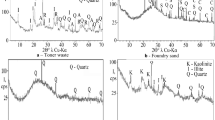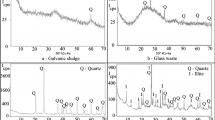Abstract
The aim of this study was the experimental tests of the mechanical properties and structure formation processes of sustainable ceramics from hazardous lead ore flotation waste, spent foundry sand, and natural red clay to produce sustainable ceramics. The lead was mined on a large scale from lead ores in the city of Adrianópolis, Brazil, for 58 years. The wastes from this activity bequeathed profound environmental and social impacts. The mechanical characteristics of twenty compositions of the ceramics were analyzed through the flexural resistance, water absorption, apparent density, and linear shrinkage; the study of the physicochemical processes of the ceramics’ mineral composite transitions and structure formation during sintering at 900–1250 °C was accomplished using XRD, SEM, EDS, AAS, and LAMMA methods. All ceramics presented flexural resistance (until 10.08 MPa) in comparison with the values established in the Brazilian national standards (> 1.5 MPa), with low water absorption and shrinkage. Ceramics with 7% of the flotation waste and 10% spent foundry sand, whose resistance reached from 3.7 to 10.1 MPa, showed the best mechanical properties. Leaching and solubility analyses by AAS method showed that there is no environmental jeopardy in using these compositions to produce sustainable ceramics.





Similar content being viewed by others
References
Zhang L, Xu Z (2018) A critical review of material flow, recycling technologies, challenges and future strategy for scattered metals from minerals to wastes. Review J Clean Prod 202:1001–1025. https://doi.org/10.1016/j.jclepro.2018.08.073
Metal Bulleting in Research, American Metal Market, 2018. http://www.metal bulletinresearch.com/Stub/10279/Consultancy.html
Hossiney N, Das P, Mohan MK, George J (2018) In plant production of bricks containing waste foundry sand— a study with Belgaum foundry industry. Case Studies in Construction Materials 9:e00170
Mackay I, Videla AR, Brito-Parada PR (2020) The link between particle size and froth stability - implications for reprocessing of flotation tailings. J Clean Prod 242:118436. https://doi.org/10.1016/j.jclepro.2019.118436
Romero-García A, Iglesias-González N, Romero R, Lorenzo-Tallafigo J, Mazuelos A, Carranza F (2019) Valorization of a flotation tailing by bioleaching and brine leaching, fostering environmental protection and sustainable development. J Clean Prod 233:573–581. https://doi.org/10.1016/j.jclepro.2019.06.118
Salokhe EP, Desai DB (2013) Application of foundry wastes and in manufacture of concrete. J Mec Civil Eng:43–48
Bhimani RD, et al. (2012) A study on foundry sand: opportunities for sustainable and economical concrete GRA - global research analysis X 60.https://doi.org/10.15373/22778160/January2013/64
Alekseev K, Mymrin V, Avanci MA, Klitzke W, Magalhães WLE, Silva PR, Catai RE, Silva DA, Ferraz FA (2019) Environmentally clean construction materials from hazardous bauxite waste red mud and spent foundry sand. J Constr Build Mat 229:116860. https://doi.org/10.1016/j.conbuildmat.2019.116860
Ercikdi B, Külekci G, Yılmaz T (2015) Utilization of granulated marble wastes and waste bricks as mineral admixture in cemented paste backfill of sulphide-rich tailings. J Constr Build Mat 93:573–583. https://doi.org/10.1016/j.conbuildmat.2015.06.042
Sua-iam G, Makul N, Cheng S, Sokrai P (2019) Workability and compressive resistance development of self-consolidating concrete incorporating rice husk ash and foundry sand waste – a preliminary experimental study. J Con Build Mat 228:116813. https://doi.org/10.1016/j.conbuildmat.2019.116813
Coppio GJL, de Lima MG, Lencioni JW, Cividanes LS, Dyer PPOL, Silva SA (2019) Surface electrical resistivity and compressive resistance of concrete with the use of waste foundry sand as aggregate. J Constr Build Mat 212:514–521. https://doi.org/10.1016/j.conbuildmat.2019.03.297
Souza CS et al (2019) Use of waste foundry sand (WFS) to produce protective coatings on aluminum alloy by plasma electrolytic oxidation. J Clean Prod. https://doi.org/10.1016/j.jclepro.2019.03.013
Matos PR et al. (2020) Self-compacting mortars produced with fine fraction of calcined waste foundry sand (WFS) as alternative filler: fresh-state, hydration and hardened-state properties. J Clean Prod https://doi.org/10.1016/j.jclepro.2019.119871
Mymrin V, Ribeiro RAC, Alekseev K, Zelinskaya E, Tolmacheva N, Catai R (2014) Environment friendly ceramics from hazardous industrial wastes. J Ceram Intern 40:9427–9437
Bhardwaj B, Kumar P (2019) Comparative study of geopolymer and alkali activated slag concrete comprising waste foundry sand. J Constr Build Mat. https://doi.org/10.1016/j.conbuildmat.2019.03.107
NBR 7170 (1993) Ceramic solid brick for masonry – specification, Rio de Janeiro
NBR 15270 (2005) Ceramic components, part 2: ceramic blocks for structural masonry and sealing - terminology and requirements, Rio de Janeiro
NBR 7178 (1997) Solo, Análise granulométrica. Rio de Janeiro
Emel A, Egemen O (2017) The effects of additives on particle size and morphology on BaSO4 crystals. In: 3rd International Conference on New Trends in Chemistry p. 91
NBR 10,004 (2004) Solid waste classification, Rio de Janeiro
Ojovan M (2008) Configurations: thermodynamic parameter sand symmetry change satglass transition. J Entropy 10:334–364
Callister WD et al (2005) Materials science and engineering: an introduction. Wiley, New York
Machado AT et al (2014) Structural ceramics made with clay and steel dust pollutants. J Appl Clay Sci. https://doi.org/10.1016/j.clay.2011.01.004
NBR 1818 (1997) Ceramic tiles - specification and methods of test. Rio de Janeiro
Dos Santos AV et al (2014) Reuse of sand disposed of foundry in lieu of sand natural in the manufacture of structural blocks. Int Conf Mat Eng Appl ICMEA
Xu R (2015) Light scattering: a review of particle characterization applications. J Particuology 8:11–21
Civera A, Pavese M, Saracco G, Specchia V (2003) Combustion synthesis of perovskite-type catalysts for natural gas combustion. J Catalysis Today 83:199–211
Anastas PT, Warner JC (1998) Green chemistry: theory and practice. Oxford University Press, Oxford
Acknowledgments
Thanks to the metallurgical company Voigt for the raw material supplied (foundry sand) and to those in charge of the administration of the (closed) mining area of the city of Adrianópolis, Brazil.
Author information
Authors and Affiliations
Corresponding author
Additional information
Publisher’s note
Springer Nature remains neutral with regard to jurisdictional claims in published maps and institutional affiliations.
Rights and permissions
About this article
Cite this article
Mymrin, V., Correia, R.A.M., Alekseev, K. et al. Sustainable materials from hazardous lead ore flotation waste in composites with spent foundry sand and clay. Int J Adv Manuf Technol 109, 1333–1344 (2020). https://doi.org/10.1007/s00170-020-05722-y
Received:
Accepted:
Published:
Issue Date:
DOI: https://doi.org/10.1007/s00170-020-05722-y




